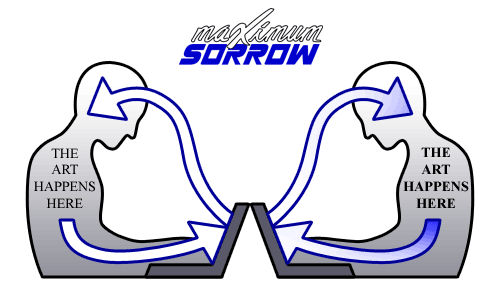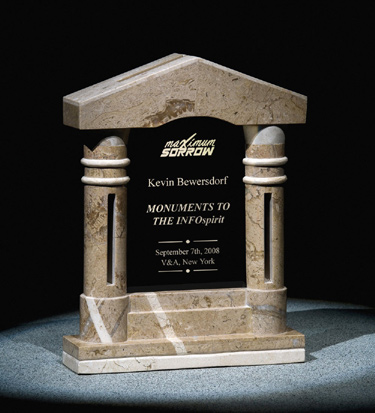
In this interview, conducted by Rhizome Editorial Fellow Gene McHugh, artist Kevin Bewersdorf discusses his philosophy toward surfing the web, the spiritual dimension of his work and his upcoming show "Monuments to the INFOspirit" at the New York gallery V&A. - Ceci Moss
Gene McHugh: The name of your website is Maximum Sorrow. What does this phrase mean to you?
Kevin Bewersdorf: Maximum Sorrow is my self brand and self corporation. It is a body of information waiting day and night to be wandered through, a corporate body whose only shape is the reverberation of the information passing through it. It is partly a philosophy of "corporate spiritualism" realized through marketing practices and continuous web surfing. I've recently written a text called "The Four Sacred Logos" that introduces some of the basic concepts of Maximum Sorrow. With each new sacred text and addition to maximumsorrow.com, I try to better understand my own spiritual relationship with the web. Hopefully the definition of Maximum Sorrow will become clearer as the site and I evolve together.
There seems to be a genuine interest in some of your recent work in locating or describing how the spiritual could interface with the digital. For example, Spirit Surfers surf club and the "Stock Photography Watermarks as the Presence of God" photo essay on Art Fag City. Is that accurate and, if so, what conclusions have you come to (if any)?
Well, the internet has hardly changed our physical lives at all, but it has drastically changed our spiritual lives. I think this perspective goes largely undiscussed when the web is viewed through less pertinent but more common sociological and technological lenses. While the internet is a physical body of wires and chips, the web is a shared non-physical realm of experience that requires many aspects of spiritual faith to interact with. We post and commune on a plane of information that we cannot touch or see. We tend to wander the web in private, confronting the massive database alone each day. We are inclined to use the web for the satisfaction of our emotional and intellectual needs rather than for our physical needs. We make pilgrimage to the same web sites at regular and repeated intervals, paying homage to them by contributing or partaking, and then we move on to our other daily needs like eating and sleeping. But all the while, we have faith that this plane of information we have become so dependent on is tangible enough to provide a worthwhile connectedness. For many of us, the web has become almost sacred, its ritual use is the embodiment of our spiritual needs. So I suppose that my conclusion is this: surfing the web can be a fulfilling spiritual experience and a direct interaction with a transcendent reality.
The written signature plays a prominent role in your self-portraits. What is it about this gesture that interests you?
There is something I have noticed about a lot of artists these days, especially net artists: they want to do everything. At one time artists were content with specialization, like in making only stained glass windows or etchings all day long. Now it is more common for artists to want to tackle all the forms of expression that the net can carry -- the still image, the moving image, music, writing, design, and so on. Many net artists may not be willing to admit it, but what they are really trying to do is to build an empire, to be a brand that offers it all. There is an absurdity to that. Having your own website is like building an unnecessary shrine to yourself. We can try to deny this by convincing ourselves that what we are doing is somehow a selfless gift, but the web has not asked us for these gifts. The web would go on without us. As net artists, we are pushing ourselves unsolicited on an already saturated marketplace. So I use my signature and various logos to point out the absurdity of this vanity, the struggle to give of yourself without becoming consumed with yourself.
The signature also makes my marketing tactics very obvious and shows that I accept myself as nothing more than a product to be marketed. Whether a net artist brands themself with a sparse list of links on a humble white field or with loud layers of noise and color or with contrived logos in a bland grid, they are constructing their own web persona for all to see. They are branding their self corporation. I think this self branding can be done with functionless art intentions rather than functioning business intentions. All the marketing materials are just shouted into the roaring whirlpool of the web where they swirl around in the great database with everyone else's personal information empires. I think these persona empires are the great artworks of our time, and they inspire me to keep building my own brand.
-->What qualifies as a "boon" in Spirit Surfing? Can you describe the physical experience that occurs when you discover a boon?
Try to wrap yourself around this cliché -- if surfing is wandering for 40 days and 40 nights in a desert, the boon is the vision brought back from the quest and the wake is the path of the whole quest's footsteps. The boon is like a jewel, a memento from a moment when the sacred nature of the web was clearly revealed to the surfer. In my experience the boon may spur on a deeper search, provide an idea for some kind of poetic game, sum up an emotional reaction to a particular zone of the web, or just float there like an impenetrable nugget outside of language. A lot of people have responded to the boon and wake separation on Spirit Surfers with confusion, as if there was some right or wrong way to interpret the juxtaposition. Really the boon/wake is only meant to set up a dialogue that, through repeated investigation, might eventually take on its own definition and allow the post to be not just about itself but also about the greater structure around it. On Spirit Surfers we have set up this structure to be continually practiced, and we are only just beginning to figure the conversation out.
How long does the "wake" of a boon typically last until it has receded?
Time really isn't part of my awareness when I am surfing. With surfing, instead of being bound to a time and space dependent experience (like sitting through the linear duration of a movie or a song or walking around the perimeter of a sculpture) we wander in a landscape that is without temperature, without light, without size, without shape, and without time. But somehow we can still come away from surfing with an experience that has a sense of order to it. Most of the really enlightening surfs I've had did not end with a post to a surf club -- surfing is so private, it rarely ends in a public act. I would invite others to start clubs that use the same boon/wake ideology, but I'm not sure if the ideology is clear enough yet to be useful to others.
In the accompanying text to your latest collection of music, Babes, you stress the virtues of struggle and mere survival in making music. Is this something specific to music or could you extend this stress to creative work, in general?
Struggle has not been a very popular theme in the American art of my lifetime. My generation is better summed up in the word "whatever," an attitude that opposes all forms of struggle. I think we are headed for a digital middle ages when struggle will become more relevant. The surge of awareness that the web has caused in us is sweeping across the marketplace like a leveling tsunami, and we're starting to drown in this sensation of information surplus. Not much seems to be rising to the surface and an endless number of self corporations are toiling away in obscurity. The general confusion and helplessness that many are experiencing over what is to be done with this massive flood of information are indications that the digital middle ages have already begun, and that these times will be about great suffering and struggle for all artists and consumers. I'm not sure how long this plague will last, but luckily after a flood there is usually a blossoming.
Your first New York solo show opens on September 7th at V&A gallery. What will be on view?
The show is called "Monuments to the INFOspirit" and will display some physical monuments to mediocre source of all information, the INFOspirit. The INFOspirit is the forth logo in "The Four Sacred Logos" and the forth brochure in "The Four Sacred Brochures." A brochure altar will be installed in the gallery where the brochures will be made available. Another monument is an animated gif mandala made from hundreds of obscure and recognizable gif icons, characters, and arrows that symmetrically pulsate around a self portrait in meditation. I wanted to try pushing a web native format to its limits by building a gif at a resolution too large to play over the internet or fit in any browser window, requiring the viewer to visit the gallery to see the file. There will also be some commemorative monuments and promotional items ordered from the web.
 Image: Kevin Bewersdorf, Monument to the INFOspirit 1, 2008
Image: Kevin Bewersdorf, Monument to the INFOspirit 1, 2008
What's your strategy for working between the gallery and the internet?
Artworks in "gallery space" are products that we pretend are not products within a business that we pretend is not a business. It's hard for many net and new media artists to deal with this, to cram their ethereal web concepts into furniture products for the wealthy so that their own artistic progress can be financed. It's also hard for art consumers to become invested in immaterial art because that would require a deeper acceptance of physical objects as trivial and ineffectual products, and most art consumers are very wrapped up in the material world of restaurants and nice coats and taxis waiting outside the gallery. I care very little about the material world, and I'm completely certain that the most profound experiences in life can't be contained by gallery walls, so the art object in "gallery space" for me can only represent a limitation, a disappointment.
I try to deal with this by presenting the object itself as pathetic and mediocre, but the information it conducts as sacred. The products I exhibit are ordered from the web and are made by a series of default operations on order forms that travel from virtual space to a physical product shippable by UPS. Once in the gallery, the product stands in for the flow of information that caused it, it is merely a conduit for the INFOspirit. I document these products on my website, completing the circle of info by joining the product back with the web. The object refers to the web and the web refers to the object. The web leads to the maximum and the sacred, the object leads to the limited and the sorrowful. When I sell an object, I see the sale as an offering, a gesture of support for the ongoing practices of my self corporation. That's really all I need -- as long as I am able to continue surfing and updating my website, I feel fulfilled.